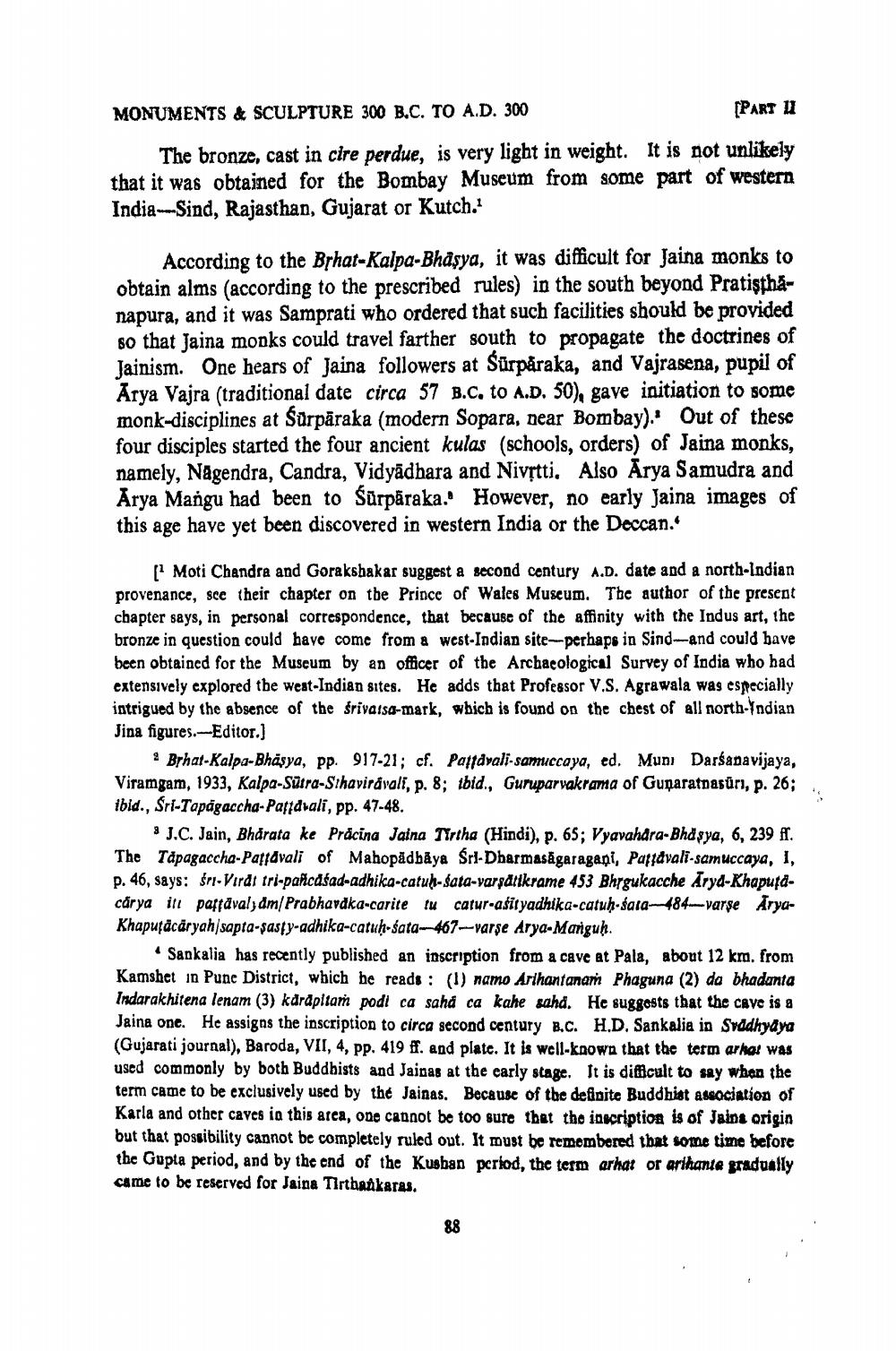________________
MONUMENTS & SCULPTURE 300 B.C. TO A.D. 300
(PART
The bronze, cast in cire perdue, is very light in weight. It is not unlikely that it was obtained for the Bombay Museum from some part of western India-Sind, Rajasthan, Gujarat or Kutch."
According to the Brhat-Kalpa-Bhasya, it was difficult for Jaina monks to obtain alms (according to the prescribed rules) in the south beyond Pratisthanapura, and it was Samprati who ordered that such facilities should be provided 80 that Jaina monks could travel farther south to propagate the doctrines of Jainism. One hears of Jaina followers at Sürpåraka, and Vajrasena, pupil of Arya Vajra (traditional date circa 57 B.C, to A.D. 50), gave initiation to some monk-disciplines at Sürpāraka (modern Sopara, near Bombay). Out of these four disciples started the four ancient kulas (schools, orders) of Jaina monks, namely, Nagendra, Candra, Vidyādbara and Nivýtti. Also Arya Samudra and Arya Mangu had been to sūrpäraka. However, no early Jaina images of this age have yet been discovered in western India or the Deccan.
[Moti Chandra and Gorakshakar suggest a second century A.D. date and a north-Indian provenance, sce their chapter on the Prince of Wales Museum. The author of the present chapter says, in personal correspondence, that because of the affinity with the Indus art, the bronze in question could have come from a west-Indian site--perhaps in Sind-and could have been obtained for the Museum by an officer of the Archacological Survey of India who had extensively explored the weat-Indian sites. He adds that Professor V.S. Agrawala was especially intrigued by the absence of the frivatsa-mark, which is found on the chest of all north-Indian Jina figures.--Editor.)
Brhat-Kalpa-Bhasya, pp. 917-21; cf. Paffdvali-samuccaya, ed. Muni Darśapavijaya, Viramgam, 1933, Kalpa-Sutra-Sthavirávali, p. 8; ibid., Guruparvakrama of Gunaratnasūri, p. 26; ibid., Sri-Tapagaccha-Patidrali, pp. 47-48.
J.C. Jain, Bharata ke Pracina Jaina Tirtha (Hindi), p. 65; Vyavahara-Bhd sya, 6, 239 fr. The Tåpagaccha-Pagdvali of Mahopädbāya Sri-Dharmasagaragani, Paffdvali-samuccaya, I, p. 46, says: śni-Virdt tri-pañcasad-adhika-catuh-sata-yarşåtikrame 453 Bhrgukacche Aryd-Khaputacarya ilt parfával, dm/Prabhavdka-carite lu catur-asityadhika-catuh-sara-484varse AryaKhaputācāryah/sapta-sasty-adhika-catuh-sata- 467-varse Arya-Manguh.
Sankalia has recently published an inscription from a cave at Pala, about 12 km. from Kamshet in Pune District, which he reads : (1) namo Arihantanam Phaguna (2) da bhadanta Indarakhitena lenam (3) kdrdpltam podl ca saha ca kahe sahd. He suggests that the cave is a Jaina one. He assigns the inscription to circa second century B.C. H.D. Sankalia in Syddhyaya (Gujarati journal), Baroda, VII, 4, pp. 419 ff. and plate. It is well-known that the term arhat was used commonly by both Buddhists and Jainas at the early stage. It is difficult to say when the term came to be exclusively used by the Jainas. Because of the definite Buddhist association of Karla and other caves in this arca, one cannot be too sure that the inscription is of Jains origin but that possibility cannot be completely ruled out. It must be remembered that some time before the Gupta period, and by the end of the Kusban period, the term arhat or arihante gradually came to be reserved for Jaina Tirthaakaras.




